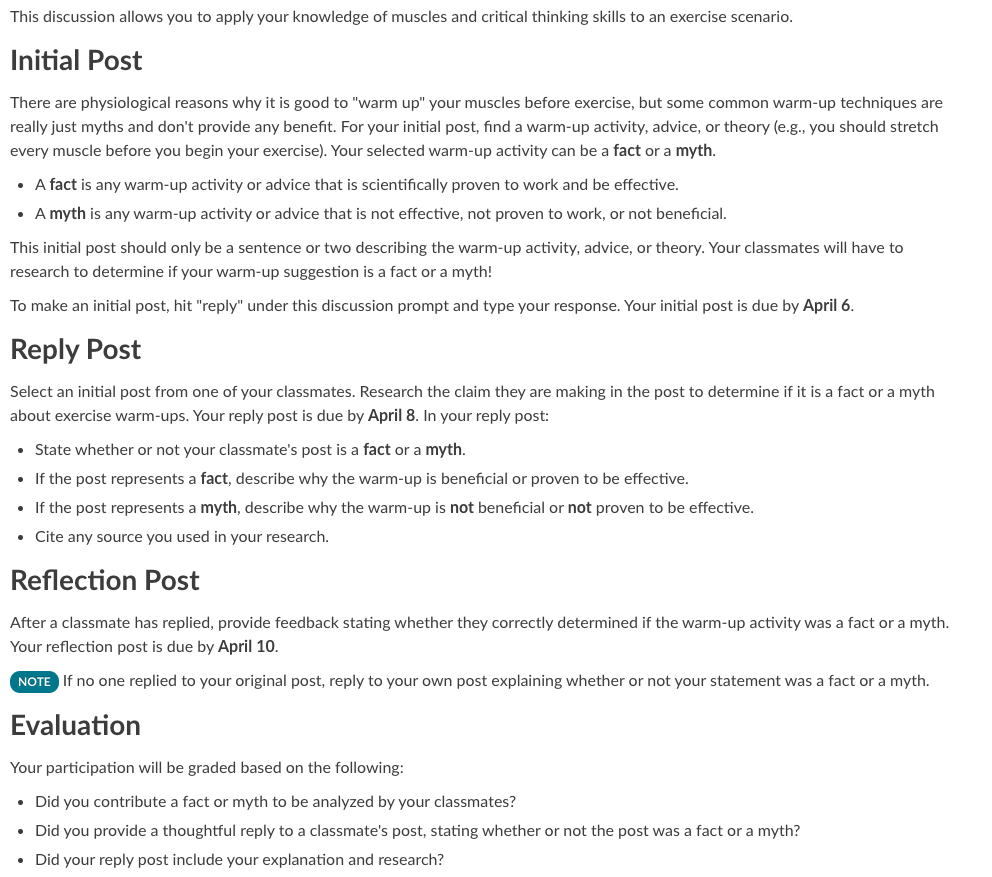Guessing Fact vs. Myth in a Gamified Discussion
Overview
Students post either a fact or a myth to a discussion forum for their classmates to debunk or confirm with peer-reviewed evidence.
Why Use This?
This discussion strategy promotes higher-level thinking and analysis skills by asking students to make a claim, evaluate said claim, apply prior knowledge and research to make a judgment about the claim’s verity, and provide feedback. This activity also creates mystery and promotes curiosity (good hooks into the discussion itself), which motivates students to research the claim and discover the correct answer. Students interact with each other more than in a typical discussion, and this format is a great way to collect a lot of information on a topic in one space.
How Does It Work?
Students are asked to post a factual or fictional claim about a specific course-related topic to a discussion forum. Once everyone has posted, each student is asked to select a classmate’s post and say whether they think the claim is fact or fiction, referencing credible research to support their assertions. The original poster then reads their classmate’s response and provides an explanation as to whether their classmate’s response is correct or incorrect and why.

This discussion allows you to apply your knowledge of muscles and critical thinking skills to an exercise scenario.
Initial Post
There are physiological reasons why it is good to “warm up” your muscles before exercise, but some common warm-up techniques are really just myths and don’t provide any benefit. For your initial post, find a warm-up activity, advice, or theory (e.g., you should stretch every muscle before you begin your exercise). Your selected warm-up activity can be a fact or a myth.
A fact is any warm-up activity or advice that is scientifically proven to work and be effective.
A myth is any warm-up activity or advice that is not effective, not proven to work, or not beneficial.
This initial post should only be a sentence or two describing the warm-up activity, advice, or theory. Your classmates will have to research to determine if your warm-up suggestion is a fact or a myth!
To make an initial post, hit “reply” under this discussion prompt and type your response. Your initial post is due by April 6.
Reply Post
Select an initial post from one of your classmates. Research the claim they are making in the post to determine if it is a fact or a myth about exercise warm-ups. Your reply post is due by April 8. In your reply post:
State whether or not your classmate’s post is a fact or a myth.
If the post represents a fact, describe why the warm-up is beneficial or proven to be effective.
If the post represents a myth, describe why the warm-up is not beneficial or not proven to be effective.
Cite any source you used in your research.
Reflection Post
After a classmate has replied, provide feedback stating whether they correctly determined if the warm-up activity was a fact or a myth. Your reflection post is due by April 10.
NOTE If no one replied to your original post, reply to your own post explaining whether or not your statement was a fact or a myth.
Evaluation
Your participation will be graded based on the following:
Did you contribute a fact or myth to be analyzed by your classmates?
Did you provide a thoughtful reply to a classmate’s post, stating whether or not the post was a fact or a myth?
Did your reply post include your explanation and research?
Keep In Mind
- At the beginning of the activity, suggest that students use peer-reviewed sources.
- Since there is an initial post, a reply post, and a reflection, be clear in the course calendar as to when each is due.
- Choose a topic where there are several proven facts, as well as persisting myths or misinformation. The choice of topic is critical to the success of this strategy. As an example, the original topic used in this discussion was to find facts and myths about exercise warm-up techniques.
- Use this activity at the beginning of a unit to identify misconceptions that already exist about the course content. You can also ask students to connect the facts or myths to information they may not have learned yet in the course.